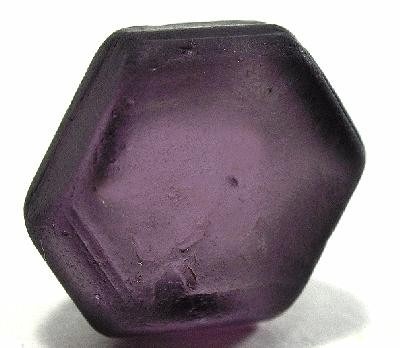Taaffeite gemstones command high prices, even though rarity does not always imply high prices in the gem world. This stone has a stunning appearance and is ideal for engagement rings. So, if money isn’t an issue, have a look and learn more.
Taaffeite: Five Things You Should Know
1. Assumed as a Spinel for a long time
Hearing the story of how this stone was discovered was one of the best parts of researching it. Count Edward Charles Richard Taaffe, a gemologist from Dublin, Ireland, was sifting through a parcel of cut and polished stones in 1945. He noticed a small mauve-colored stone weighing 1.419 carats that appeared like spinel might be something different while examining them. The gem was also doubly refractive, which was significant. Spinel has a single refractive index, similar to garnet and diamond. Curious and wanting to learn more, Taaffe sent the gem to the London Chamber of Commerce’s Laboratory for testing. The stone was named after the gemologist after researchers confirmed it was a new species. According to the International Gem Society, a portion of the new gemstone was used for analysis, and the rest was returned to Taaffe as a 0.55-carat stone, making it the first official chunk of taaffeite. Taaffeite was the first-ever faceted gemstone discovered, and it is still the only one. This is extraordinary, according to Carl Larson of gem dealer Pala International, because cut gems are more difficult to identify than rough. After all, the observer loses clues such as the crystal system.
2. How it compares to spinel and how it differs
Many taaffeites resemble spinel at first glance. Only when you look at the details do you notice the differences. Taaffeite is distinguished by its birefringence, as previously stated. Taaffeite differs from spinel in terms of chemical composition and crystal structure. Taaffeite forms in hexagonal crystals, whereas spinel forms in cubic crystals.
3. It can only be found in a few places on the planet.
For a long time, the origin of taaffeite was unknown. Small fragments were eventually discovered in Sri Lanka and southern Tanzania. According to the IGS, the substance also came from Myanmar, and some lower-grade taaffeite was discovered in China and Russia. It’s not surprising that the gemstone has been mistaken for spinel, given its similar appearance and the fact that it’s found mixed in with spinel parcels.
4. It is also uncommon
There were only a few samples known for many years after Taaffe’s discovery, and taaffeite remains one of the world’s rarest minerals, according to IGS. Only about 10 specimens had been identified at the time, according to an article in the summer 1982 issue of Gems & Gemology, and estimates for how much taaffeite is currently in circulation are still fairly small. It is only used for cut gemstones because of its extreme rarity, according to multiple sources. Larson claims that in his seven years with Pala International, he has only succeeded with about 20 taaffeite stones and sold four fine-quality stones. The few taaffeites on the market, according to Bonhams, are typically light in color and small.
5. There are good options at a variety of price points, but the high-end items are quickly snapped up.
According to Howard Fensterman Minerals, because much of the material is lighter in saturation, it can be priced in the $1,500-$2,500 per carat range. High-quality pieces, like most gemstones, are rare and therefore expensive. The light-pink and dark-purple materials, according to Larson, are priced between $800 and $2,500 per carat. Finer colors with more saturation can fetch between $5,500 and $7,500 per carat, while intense colors with a clean interior can fetch up to $15,000 per carat. These fine stones sell quickly, Larson added, noting that most buyers he’s met have done their homework and know as much, if not more, about the gem than he does. Taaffeite has even been sold at auction, with a lavender kite-shaped taaffeite weighing 5.34 carats selling for $20,000 including buyer’s premium at Bonhams in 2018. Multicolor gemstone wholesaler David Weinberg said there are three distinct markets for taaffeite: collectors, engagement rings, and collector-investors. While demand has dipped as a result of the coronavirus pandemic, he believes it still outperforms most stones, a feat he attributes to the growing popularity of rare gemstones. Larson also mentioned that fine stones sell quickly, as well as any substance that is eye-clean, has vibrant color, and is well-cut, regardless of the size.
Important Information about Taaffeite
- Name – Taaffeite
- Varieties – Musgravite
- Stone Sizes – The first taaffeite, weighing 1.419 carats, was discovered in a cluster of mauve spinels; part of it was evaluated, and the remaining was recut into a 0.55-carat gem. This was given to Count Edward Charles Richard Taaffe, a Bohemian and an Irish gemologist living in Dublin. The Geological Museum in London now has a second taaffeite stone, weighing 0.86 carats. The S1collection houses a 0.84-carat taaffeite, as well as a 5.34-carat dark brownish-purple gem identified at the Gemological Institute of America laboratory in New York. Many more stones, possibly as many as 50, have been discovered. A Sri Lankan collector owns a perfect mauve oval weighing 13.22 carats. A 10.13-carat gray-mauve oval with slight additives, as well as a pink oval, weighing approximately 11.24 carats and lots of smaller stones, can be found in another private collection. A 3.04-carat pale mauve Burmese taaffeite has been discovered.
- Colors – Colorless, greenish, pinkish, lilac to purple, bluish, bluish violet, red
- Fracture – Conchoidal
- Hardness – 8-8.5
- Cleavage – Imperfect and fair
- Crystallography – Hexagonal; crystal microscopic, prismatic, also known chiefly as rounded pebbles and cut gemstones.
- Luminescence Type – Fluorescent, UV-long, X-ray Colors
- Phenomena – Chatoyancy or also known as very rare.
Taaffeite is a rare gemstone for a variety of reasons. It has been discovered to be a million times extra rare than a diamond. It is not only one of the world’s rarest gems, but it is also the only one that was discovered as a polished and faceted gem. The taaffeite stone, which ranges in color from clear mauve to purple-red, was named after Richard Taaffe, the gemologist who first discovered it in 1945. When he looked at his haul, he noticed that one of the gems had double refraction and wasn’t a regular spinel like the others. Because it turned out to be something unique, he was given the honor of having the stone named after him. They were in a box of Sri Lankan gemstones, most of which had single refraction, whereas the taaffeite stone had double refraction. Since then, small deposits have been discovered in China, Sri Lanka, and southern Tanzania, ranging in color from purple to red and with a hardness of 8 to 8.5. It is said that red Taaffeite is extremely rare. Only about ten taaffeite stones have red coloring on the planet. The world’s only taaffeite stones would only fill half a measuring cup.


